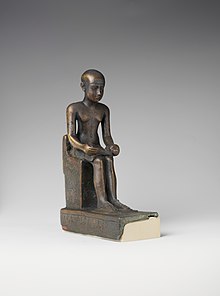
Back Imhotep Afrikaans إمحوتب Arabic ايمحوتب ARZ Imhotep AST İmhotep Azerbaijani Имхотеп Bashkir Імхатэп Byelorussian Имхотеп Bulgarian ইমহোটেপ Bengali/Bangla Imhotep Breton
Imhotep | |
|---|---|
| Ancient Egyptian: Jj m ḥtp | |
 Statuette of Imhotep, 664–30 BC | |
| Burial place | Saqqara (probable) |
| Other names | Asclepius (name in Greek) Imouthes (also name in Greek) |
| Occupation(s) | chancellor to the Pharaoh Djoser and High Priest of Ra |
| Years active | c. 27th century BC |
| Known for | Being the architect of Djoser's step pyramid |
| Imhotep in hieroglyphs | ||||||
|---|---|---|---|---|---|---|
Imhotep Jj m ḥtp He who comes in peace | ||||||
Jj m ḥtp | ||||||
Jj m ḥtp | ||||||
| Greek Manetho variants: | ||||||
| Part of a series on |
| Ancient Egyptian religion |
|---|
 |
|
|
Imhotep (/ɪmˈhoʊtɛp/;[1] Ancient Egyptian: ỉỉ-m-ḥtp "(the one who) comes in peace";[2] fl. late 27th century BC) was an Egyptian chancellor to the Pharaoh Djoser, possible architect of Djoser's step pyramid, and high priest of the sun god Ra at Heliopolis. Very little is known of Imhotep as a historical figure, but in the 3,000 years following his death, he was gradually glorified and deified.
Traditions from long after Imhotep's death treated him as a great author of wisdom texts[3] and especially as a physician.[4][5][6][7][8] No text from his lifetime mentions these capacities and no text mentions his name in the first 1,200 years following his death.[9][10] Apart from the three short contemporary inscriptions that establish him as chancellor to the Pharaoh, the first text to reference Imhotep dates to the time of Amenhotep III (c. 1391–1353 BC). It is addressed to the owner of a tomb and reads:
The wab-priest may give offerings to your ka. The wab-priests may stretch to you their arms with libations on the soil, as it is done for Imhotep with the remains of the water bowl.
— Wildung (1977)[3]
It appears that this libation to Imhotep was done regularly, as they are attested on papyri associated with statues of Imhotep until the Late Period (c. 664–332 BC). Wildung (1977)[3] explains the origin of this cult as a slow evolution of intellectuals' memory of Imhotep, from his death onward. Gardiner finds the cult of Imhotep during the New Kingdom (c. 1550–1077 BC) sufficiently distinct from the usual offerings made to other commoners that the epithet "demigod" is likely justified to describe his veneration.[11]
The first references to the healing abilities of Imhotep occur from the Thirtieth Dynasty (c. 380–343 BC) onward, some 2,200 years after his death.[10]: 127 [3]: 44
Imhotep is among the few non-royal Egyptians who were deified after their deaths, and until the 21st century,[clarification needed] he was one of nearly a dozen non-royals to achieve this status.[12][13] The center of his cult was in Memphis. The location of his tomb remains unknown, despite efforts to find it.[14] The consensus is [citation needed]that it is hidden somewhere at Saqqara.
- ^ "Imhotep". Collins Dictionary. Retrieved 25 September 2014.
- ^ Ranke, Hermann (1935). Die Ägyptischen Personennamen [Egyptian Personal Names] (PDF) (in German). Vol. 1: Verzeichnis der Namen. Glückstadt: J. J. Augustin. p. 9. Retrieved 24 July 2020.
- ^ a b c d Wildung, D. (1977). Egyptian Saints: Deification in pharaonic Egypt. New York University Press. p. 34. ISBN 978-0-8147-9169-1.
- ^ Osler, William (2004). The Evolution of Modern Medicine. Kessinger. p. 12.
- ^ Musso, C. G. (2005). Imhotep: The dean among the ancient Egyptian physicians.[full citation needed]
- ^ Willerson, J. T.; Teaff, R. (1995). "Egyptian Contributions to Cardiovascular Medicine". Texas Heart Institute Journal: 194.[full citation needed]
- ^ Highfield, Roger (10 May 2007). "How Imhotep gave us medicine". The Telegraph. London, UK. Archived from the original on 12 January 2022.
- ^ Herbowski, Leszek (2013). "The maze of the cerebrospinal fluid discovery". Anatomy Research International. 2013 596027: 5. doi:10.1155/2013/596027. LCCN 2011243887. OCLC 733290677. PMC 3874314. PMID 24396600.
- ^ Teeter, E. (2011). Religion and Ritual in Ancient Egypt. p. 96.[full citation needed]
- ^ a b Baud, M. (2002). Djéser et la IIIe dynastie [Djoser and the Third Dynasty] (in French). p. 125.[full citation needed]
- ^ Hurry, Jamieson B. (2014) [1926]. Imhotep: The Egyptian god of medicine (reprint ed.). Oxford, UK: Traffic Output. pp. 47–48. ISBN 978-0-404-13285-9.
- ^ Troche, Julia (2021). Death, Power and Apotheosis in Ancient Egypt: The Old and Middle Kingdoms. Ithaca: Cornell University Press.
- ^ Albrecht, Felix; Feldmeier, Reinhard, eds. (2014). The Divine Father: Religious and philosophical concepts of divine parenthood in antiquity (e-book ed.). Leiden, Netherlands; Boston, Massachusetts: Brill. p. 29. ISBN 978-90-04-26477-9.
- ^ "Lay of the Harper". Reshafim.org.il. Retrieved 23 June 2015.
© MMXXIII Rich X Search. We shall prevail. All rights reserved. Rich X Search